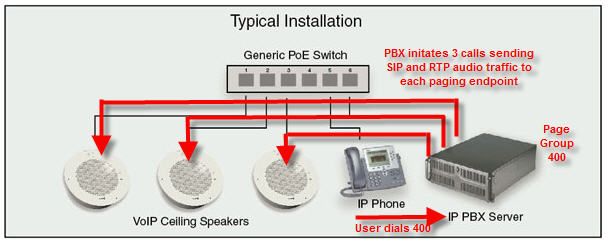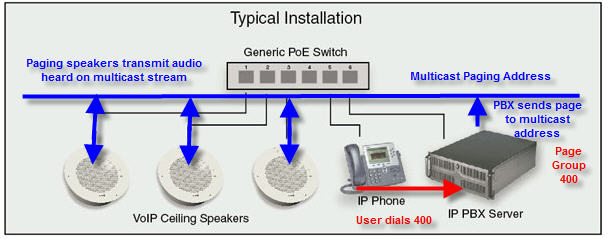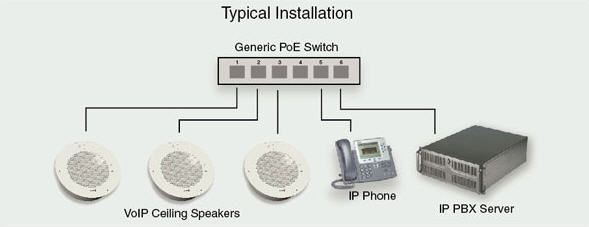In this blog we will detail the common methods that paging is delivered over an IP network and discuss how these methods are deployed over a network infrastructure such as an IP PBX like 3CX or Asterisk, paging endpoints, IP Phones for desktop paging, overhead speakers, and gateways that are SIP enabled for large paging solutions. Companies like Cyberdata have SIP based overhead ceiling speakers, SIP based paging amplifiers, paging gateways and loudspeakers with horns to accompany them.
UNICAST IP PAGING
To understand how IP paging works, we will look at the two types of paging solutions that are supported on most IP based PBX’s. The first is called “unicast”, or more commonly, a unicast page. Unicast pages are delivered on a one to one basis and the IP PBX is the source for this page. In most common unicast paging setups, administrators will setup a single paging group or multiple page groups in the IP PBX configuration. For our example, we’ll use a paging ring group assigned to extension 400.
Paging group 400 then contains SIP extensions that belong to individual users on the system and these extensions are physical SIP endpoints such as an IP Phone. In unicast paging environments, when a user dials paging group 400 from their phone, the PBX sends SIP and RTP audio traffic to and from each one of the endpoints in the ring group. Once the PBX connects to the endpoints, they will auto-answer and the caller can begin speaking. In a 3CX environment this type of page would only use 1 simultaneous call to the ring group, as the audio traffic is one way to the endpoints in the ring group. On some PBX's, and in the example below, each endpoint has a connection established to it from the device that is paging, thus taxing the PBX's CPU and processing power. 3CX handles this differently and does not burden the PBX when paging to ring group.
MULTICAST IP PAGING
Multicast paging achieves the same outcome as unicast paging but delivers each page much differently. In most multi-cast paging environments, administrators will specify a single multi-cast paging IP address in the IP PBX setup. They will then configure each paging endpoint such as an IP Phone, overhead speaker, or amplifier, to “listen in” on that multicast addresses. The IP Phones or other paging endpoints are always “listening” to this address and when RTP packets or audio is heard, the phone or paging endpoints simply play that audio stream.
In both of these paging environments, two types of paging can be performed. Desktop paging and overhead paging. We will talk about these two options and offer product suggestions based on these examples.
DESKTOP PAGING
Desktop paging is exactly what it sounds like, paging at the desktop. This involves an IP Phone that supports paging. During a desktop page, the IP PBX will usually be configured for a page group or groups depending on the scenario, and a user will simply dial into that page group to initiate the desktop page. The SIP extensions of the users inside that page group in the IP PBX are then paged either via a unicast or multicast stream.
Desktop pages are delivered directly to the IP Phone, triggering it to immediately go off-hook and present the page of the speakerphone. So, from a hardware standpoint, you need an IP Phone that supports a speakerphone, which is the vast majority of them on the market today. If you are unsure, please don’t hesitate to contact us and speak with one of our sales representatives.
Desktop paging can also be configured to “play a tone” first before the page comes through the speaker to alert the user that a page is being delivered. Also, pages can be configured to interrupt a user on a call or wait until the user has completed the call to page through. In cases where a page will interrupt a user during a phone conversation, the party that this user is speaking with will not be able to hear the page; however this may cause a distraction to all users on the conversation.
OVERHEAD PAGING
The second type of IP Paging is overhead paging. Great advancements have been made in this department over the past few years to cater to new IP based overhead paging solutions. Most of these products are powered via POE so installation is easily accomplished with 1 cable. Configuration is very easy as most of these endpoints are based upon SIP standards and are easily configured with a SIP extension (just like you would with an IP Phone) via the products web GUI configuration. Simply add these endpoints as SIP extensions to a new or existing page group on your SIP PBX and dial the page group extension.
EXISTING ANALOG PAGING SYSTEMS
Cyberdata Paging Gateway
You may come across a client who has converted their phone system to an IP PBX but they want to incorporate their existing analog paging system to their new VoIP phone system. Cyberdata offers legacy based devices that will help address this need. The first is the Cyberdata Paging Gateway. Like any gateway does in the IP world, it integrates 2 different networks together. Most commonly, this is done over a voice circuit where voice gateways connect to standard RJ-11 analog POTS lines or analog telephones and allow communication to an IP network or IP based PBX. The same is true for the Cyberdata Paging gateway however this gateway is used to connect older legacy analog paging systems to an IP network. When users dial the page group extension, the IP PBX will ring the SIP extension registered to the paging gateway and it will send the page to the analog paging equipment attached to it.
Cyberdata Zone Controller
The second device used in the paging world to incorporate older analog paging systems with new IP based PBX’s is the Cyberdata Zone Controller. Unlike the paging gateway, the zone controller contains (4) standard audio out ports which are used to connect to existing analog amplifiers. In turn, speakers or horns would then be connected to those amplifiers.
Once the standard audio connection is made between the zone controller and existing amplifiers, the zone controller will communicate to the IP PBX via its LAN port over the IP network. The zone controller contains 4 page zones and allows for up to 15 zone groups.



Steve Stoveld
Comments
Jases Brown
It seems, actually, like 3CX still handles each device in a paging group separately and uses a call license for each. I just tested and my calls in use increased with each device added to the paging group.